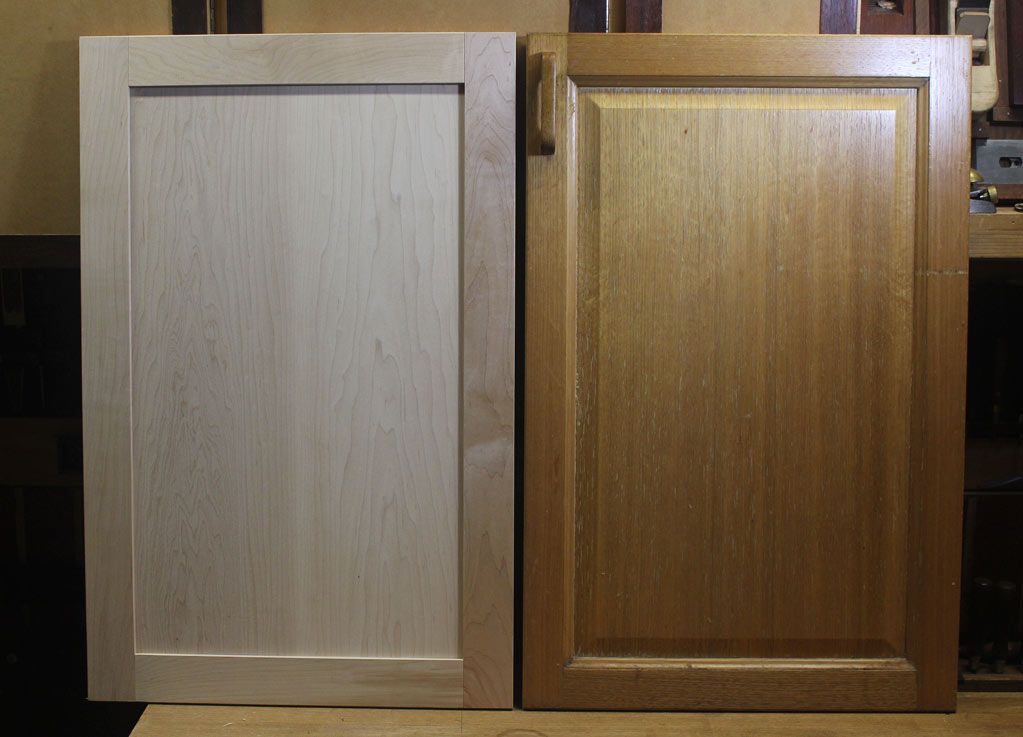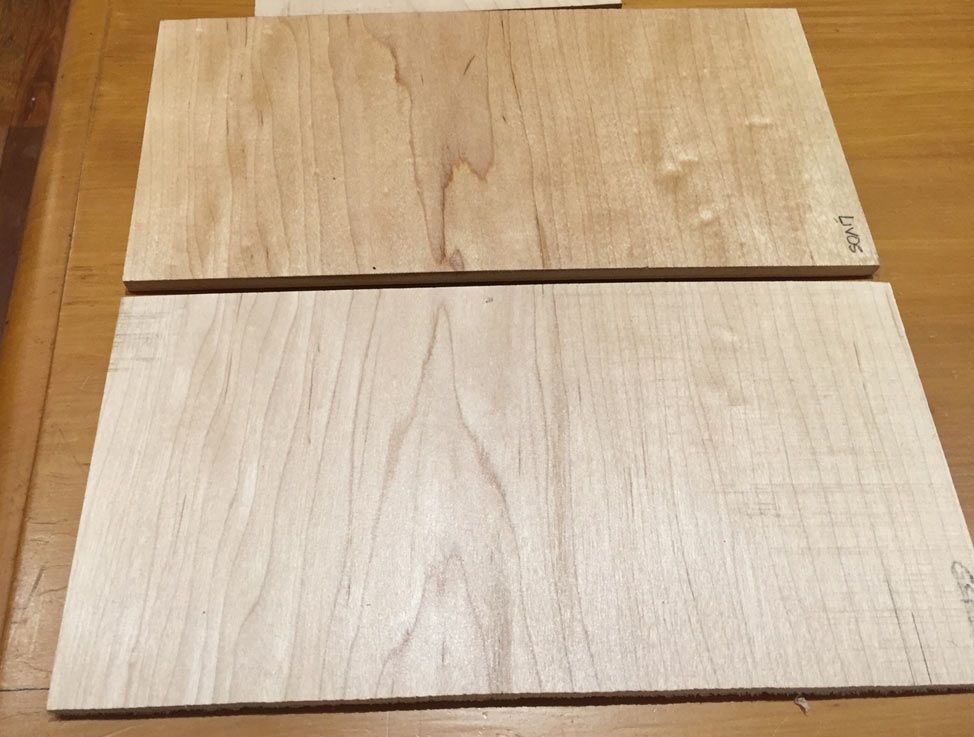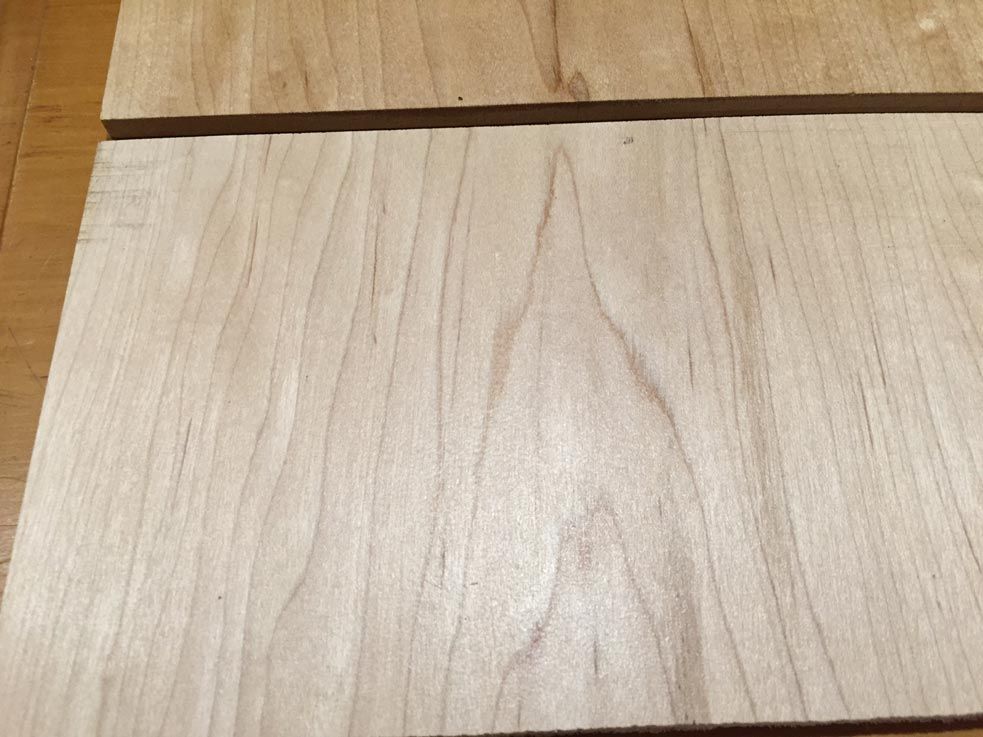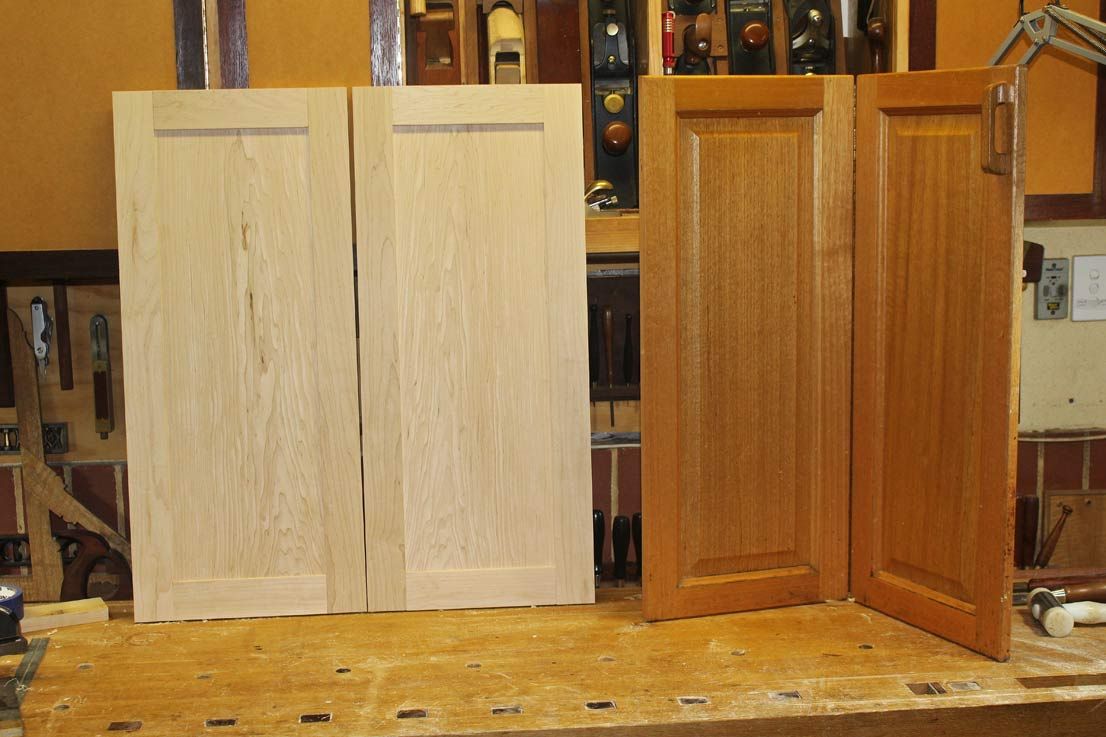 Needs Pictures: 0
Needs Pictures: 0
 Picture(s) thanks: 0
Picture(s) thanks: 0
Results 1 to 15 of 16
-
29th November 2016, 01:11 AM #1
 Finish suggestions for (USA) Hard Maple kitchen doors
Finish suggestions for (USA) Hard Maple kitchen doors
What I am after is a durable finish that remains clear and retards yellowing, and that can be applied by brush or, preferably, wiping. I am not interested in a two-pack finish that requires spraying with special masks and protection. I would consider a suitable spray can option.
I have started building the doors for our kitchen. Hard Maple is so nice to work. Planes beautifully and easily. I cannot believe how easily!
The design is a Shaker style, chosen for a clean, simple look. This will replace a 22 year-old existing kitchen in Tasmanian Oak with a more traditional raised panel style.
Unfinished and even not yet glued - first door ...

Regards from Perth
DerekVisit www.inthewoodshop.com for tutorials on constructing handtools, handtool reviews, and my trials and tribulations with furniture builds.
-
29th November 2016 01:11 AM # ADSGoogle Adsense Advertisement
- Join Date
- Always
- Location
- Advertising world
- Posts
- Many
-
29th November 2016, 02:47 AM #2

when you add up the cost of the number of cans you would need, I think you'll find it would be a whole lot cheaper to build your own 2-pack spray booth or take the doors to a professional finisher.
as to a suitable finish.
It's a kitchen -- which is a relatively harsh environment in terms of moisture, spills, cleaning products, etc.
I can't really recommend an easy to apply non-yellowing finish -- though I've been told that the "water white" polyurethanes exhibit the least yellowing.
Probably unwelcome, but I think for the number of doors involved -- 25? -- you really should get the finishing done off site.regards from Alberta, Canada
ian
-
29th November 2016, 03:44 AM #3

Any thoughts about Minwax Polycrylic? Water-based, clear, non-yellowing, brush on or spray can.
Regards from Perth
DerekVisit www.inthewoodshop.com for tutorials on constructing handtools, handtool reviews, and my trials and tribulations with furniture builds.
-
29th November 2016, 05:31 AM #4

from https://www.minwax.ca/wood-finishing...lear-finishes/
Water-based:Looks like milk in the can but dries crystal clear. Good if you're trying to preserve a wood's colour. More watery than oil-based polys, so more coats are needed. Dries quickly. Usually lower in VOCs than oil-based finishes but still requires good ventilation during application. Cleans up with soap and water. Never use ammonia-based cleaners on the cured film.
which for a kitchen or laundry or bathroom would have me looking for something elseregards from Alberta, Canada
ian
-
29th November 2016, 11:13 AM #5
 GOLD MEMBER
GOLD MEMBER











- Join Date
- Jun 2005
- Location
- Helensburgh
- Posts
- 7,696

It is a tough environment so it needs a tough finish. I have no comment on the anti-yellowing but I have used Cabot's single pack floor finish on restaurant tables with success (so far) but we did spray it. It is suppose to be brush on only but we could not get the brush marks out so contrary to Cabot's technical advise it got sprayed and looked great.
Floor Finish - Polyurethane - Oil Based | Cabots Cfp FloorCHRIS
-
29th November 2016, 12:19 PM #6
 GOLD MEMBER
GOLD MEMBER











- Join Date
- Oct 2014
- Location
- Caroline Springs, VIC
- Posts
- 1,645

I would use Hard Shellac. It doesn't change the colour of US Maple much, exact same as wetting it with water but you get a nice sheen from it. US Maple will turn yellow with time. Not quite as bad as the puke yellow you get with oil based varnishes but enough to give it that dated feel unless you can see it as patina. I wouldn't stress too much about the kitchen being a harsh environment. The steam goes out through the rangehood/window, the grease splashes land on the benchtops or floor, sometimes ceiling
 I can honestly say that I have never cleaned the kitchen doors in my place and they look clean to me. If I was a clean freak, I would only be using a damp rag possibly charged with dettol or similar to kill germs.
I can honestly say that I have never cleaned the kitchen doors in my place and they look clean to me. If I was a clean freak, I would only be using a damp rag possibly charged with dettol or similar to kill germs.
-
29th November 2016, 05:06 PM #7

Chris, the one rule of thumb I have learned so far is that only a water-based acrylic finish remains clear and does not go yellow. Anything that is oil-based immediately adds a yellow tinge. So I am after a water-based finish.
One recommended is Minwax Polycrylic. This is available in Oz.
Apparently better (more durable) are Hydrocote Resisthane Plus, and General Finish Enduro, neither of which I can find locally.
Regards from Perth
DerekVisit www.inthewoodshop.com for tutorials on constructing handtools, handtool reviews, and my trials and tribulations with furniture builds.
-
29th November 2016, 07:02 PM #8

these might be available to commercial finishers, but not retail customers.
another option might be an automotive paint -- I think there are some UV stable clear finishes used by the car industry
also, there should be no shame in sending a project outside your shop for finishing. Afterall, it's how Bob Flexnor makes his living.regards from Alberta, Canada
ian
-
29th November 2016, 07:56 PM #9

Derek, the 3 kitchens I've done all got single-pack polyurethane (oil-based). One is getting on for 20 years old, now and still looks remarkably good, apart from the finish yellowing, as it does. The finish has stood up far better than I initially expected, particularly on the wooden tops. Unless you are an especially messy chef, your doors should be fine with a good poly finish.
"Water-clear" finishes don't stay clear forever, they colour up over time, too, but it certainly takes much longer than for the solvent-based types - 8-10 years before I really noticed it on the couple of things I've used it on.
'Ragging' on works extremely well with the solvent-based poly (I dilute to at least 60% turps), but I've not tried that technique with the water-based stuff - I guess it should work ok?? It's the only way I know to get a decent surface without build-up - long ago gave up on brushes! Just finished a couple of Blackwood occasional tables for two of my off spring, in fact, & that's the finish they got. Not quite as fine as a good French polish, but close, and a lot more resilient! Blackwood table.jpg
Cheers,IW
-
30th November 2016, 05:11 PM #10

I took the plunge - probably pretty safe (albeit it pricey!) - to use General Finishes QTHS High Performance Water Based Topcoat. Via Amazon as it is not available in Oz, and I cannot find something similar.
I was alerted me to a review done by FWW in 2006. This, along with recommendations from a few others, really supported its choice as the top finish that was clear (non-yellowing), non plastic finish, maximum protection, able to be applied with a foam brush, and quick drying for re-coating.
Thanks all.
Regards from Perth
DerekVisit www.inthewoodshop.com for tutorials on constructing handtools, handtool reviews, and my trials and tribulations with furniture builds.
-
13th December 2016, 08:13 PM #11
 Senior Member
Senior Member











- Join Date
- Dec 2004
- Location
- Perth
- Posts
- 324

Bit late to the party here but the Osmo range is worth a look. The polyx oil with a coat of wood protector before would do the trick. There's also a raw product that retains the natural look of timber and resists yellowing.
I'm surprised there's not more mention of the osmo stuff on here. It's all natural and amazing. I installed a vanity in a clients home 18 months ago that was finished in the wood protector and the polyx oil and it's doing great. I've also done a load of tables and a bar for a wedding hire company using the polyx oil. After it cures, it's bomb proof...
VCS in Osborne park are the distributors.
-
22nd December 2016, 09:42 PM #12

I can't really agree that the kitchen is a tough environment for kitchen doors. For the counter tops, maybe, but not the doors. That door that you made is a work of art, I have to say and I would not discount a good quality oil finish as an option. There are several types available - teak, linseed, danish blend. The oil penetrates the grain without swelling it too much and will bring out that beautiful swirling grain that you've got going. Most oil must be applied in excess to that the surface is thoroughly soaked and then the excess is wiped off with a rag 10 or 20 minutes later... you can line up 6 or so doors on a tressle and by the time you have applied the first excess coat on the last the first will be ready for wiping down.
The oil does not dry - it CURES - meaning that a fine water resistant film is formed all over the wooden surface.
I like a slightly yellowed tinge myself... and timber will do that through exposure to UV light anyway, no matter what clear finish you use.
Water based finishes will swell and raise the grain leaving finely sanded surfaces feeling rougher than after sanding... That's one of the reasons that the manufacturers recommend sanding between coats. I read in a magizine a recommendation to use a solven based polyurethane as the first coat followed by top coats with water based finish. This prevents the grain from swelling.
-
23rd December 2016, 12:37 AM #13

Hi Garcia
I've used oil finishes for a few decades and am pretty familiar with them. They are my preference. In particular, I like Livos Universal Wood Oil. It would be my first choice ... except that my wife wants the Maple to remain white and not turn yellow. It is for this reason I searched out and settled on General Finishes water-based poly. The one issue - a big issue - was that water-based finishes do not brush on well. Any type of brush. So I decided to spray it. I do not have spray equipment, but have experience with Preval refillable spray cans.
Here is a Livos-wiped surface and a GF water-based poly sprayed comparison. You can see the yellowing from 2 coats of Livos vs hardly any colour change from the GF ...

Close up of the GF (iphone camera) ..

And an another example of the doors under construction (about a third of the way so far through construction) ...

Regards from Perth
DerekVisit www.inthewoodshop.com for tutorials on constructing handtools, handtool reviews, and my trials and tribulations with furniture builds.
-
23rd December 2016, 09:24 AM #14
 Senior Member
Senior Member











- Join Date
- Dec 2004
- Location
- Perth
- Posts
- 324


Just for future reference, this is 2 coats of osmo raw on Marri. You can also dial the white down a bit by just doing one coat of raw and one of clear.
-
23rd December 2016, 09:36 AM #15
 GOLD MEMBER
GOLD MEMBER











- Join Date
- Jun 2005
- Location
- Helensburgh
- Posts
- 7,696
Similar Threads
-
Hard Maple Going Yellow
By Eli. in forum FINISHINGReplies: 2Last Post: 15th January 2013, 08:44 AM -
Finish raw NGR kitchen cabinet doors
By woodmark in forum FINISHINGReplies: 1Last Post: 28th July 2011, 06:44 AM -
hard maple kitchen island
By ryanarcher in forum WOODWORK PICSReplies: 11Last Post: 15th June 2004, 12:51 PM



 Thanks:
Thanks:  Likes:
Likes: 
 Reply With Quote
Reply With Quote
